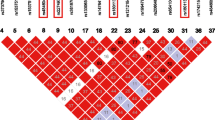Abstract
Purpose
Neural tube defects (NTDs) are one of the most prevalent and the most severe congenital malformations worldwide. Studies have confirmed that folic acid supplementation could effectively reduce NTDs risk, but the genetic mechanism remains unclear. In this study, we explored association of single nucleotide polymorphisms (SNP) within folate metabolic pathway genes with NTDs in Han population of Northern China.
Methods
We performed a case-control study to compare genotype and allele distributions of SNPs in 152 patients with NTDs and 169 controls. A total of 16 SNPs within five genes were genotyped by the Sequenom MassARRAY assay.
Results
Our results indicated that three SNPs associated significantly with NTDs (P<0.05). For rs2236225 within MTHFD1, children with allele A or genotype AA had a high NTDs risk (OR=1.500, 95%CI=1.061~2.120; OR=2.862, 95%CI=1.022~8.015, respectively). For rs1801133 within MTHFR, NTDs risk markedly increased in patients with allele T or genotype TT (OR=1.552, 95%CI=1.130~2.131; OR=2.344, 95%CI=1.233~4.457, respectively). For rs1801394 within MTRR, children carrying allele G and genotype GG had a higher NTDs risk (OR=1.533, 95%CI=1.102~2.188; OR=2.355, 95%CI=1.044~5.312, respectively).
Conclusions
Our results suggest that rs2236225 of MTHFD1 gene, rs1801133 of MTHFR gene and rs1801394 of MTRR gene were associated with NTDs in Han population of Northern China.
Similar content being viewed by others
Change history
14 February 2018
The original version of this article unfortunately contained an error.
References
Greene ND, Stanier P, Copp AJ (2009) Genetics of human neural tube defects. Hum Mol Genet 18:R113–R129
Copp AJ, Brook FA, Estibeiro JP, Shum AS, Cockroft DL (1990) The embryonic development of mammalian neural tube defects. Prog Neurobiol 35:363–403
Molloy AM, Pangilinan F, Brody LC (2017) Genetic risk factors for folate-responsive neural tube defects. Annu Rev Nutr 37:269–291
Au KS, Findley TO, Northrup H (2017) Finding the genetic mechanisms of folate deficiency and neural tube defects—leaving no stone unturned. Am J Med Genet A 173:3042–3057
van der Linden IJ, Afman LA, Heil SG, Blom HJ (2006) Genetic variation in genes of folate metabolism and neural-tube defect risk. Proc Nutr Soc 65:204–215
Selhub J, Jacques PF, Wilson PW, Rush D, Rosenberg IH (1993) Vitamin status and intake as primary determinants of homocysteinemia in an elderly population. JAMA 270:2693–2698
Wang Y, Liu Y, Ji W, Qin H, Wu H, Xu D, Tukebai T, Wang Z (2015) Analysis of MTR and MTRR polymorphisms for neural tube defects risk association. Medicine (Baltimore) 94:e1367
Yadav U, Kumar P, Yadav SK, Mishra OP, Rai V (2015) Polymorphisms in folate metabolism genes as maternal risk factor for neural tube defects: an updated meta-analysis. Metab Brain Dis 30:7–24
Momb J, Appling DR (2014) Mitochondrial one-carbon metabolism and neural tube defects. Birth Defects Res A Clin Mol Teratol 100:576–583
Field MS, Kamynina E, Stover PJ (2016) MTHFD1 regulates nuclear de novo thymidylate biosynthesis and genome stability. Biochimie 126:27–30
Meng J, Han L, Zhuang B (2015) Association between MTHFD1 polymorphisms and neural tube defect susceptibility. J Neurol Sci 348:188–194
Yan L, Zhao L, Long Y, Zou P, Ji G, Gu A, Zhao P (2012) Association of the maternal MTHFR C677T polymorphism with susceptibility to neural tube defects in offsprings: evidence from 25 case-control studies. PLoS One 7:e41689
Yu Y, Wang F, Bao Y, Lu X, Quan L, Lu P (2014) Association between MTHFR gene polymorphism and NTDs in Chinese Han population. Int J Clin Exp Med 7:2901–2906
Gonzalez-Herrera L, Garcia-Escalante G, Castillo-Zapata I, Canto-Herrera J, Ceballos-Quintal J, Pinto-Escalante D, Diaz-Rubio F, Del AR, Orozco-Orozco L (2002) Frequency of the thermolabile variant C677T in the MTHFR gene and lack of association with neural tube defects in the State of Yucatan, Mexico. Clin Genet 62:394–398
Liu ZZ, Zhang JT, Liu D, Hao YH, Chang BM, Xie J, Li PZ (2013) Interaction between maternal 5,10-methylenetetrahydrofolate reductase C677T and methionine synthase A2756G gene variants to increase the risk of fetal neural tube defects in a Shanxi Han population. Chin Med J 126:865–869
Olteanu H, Banerjee R (2001) Human methionine synthase reductase, a soluble P-450 reductase-like dual flavoprotein, is sufficient for NADPH-dependent methionine synthase activation. J Biol Chem 276:35558–35563
Ouyang S, Li Y, Liu Z, Chang H, Wu J (2013) Association between MTR A2756G and MTRR A66G polymorphisms and maternal risk for neural tube defects: a meta-analysis. Gene 515:308–312
Acknowledgments
We are grateful to all the families for their NTDs-affected children enrolled in this study. We also extend our thanks to the staff of Tianjin Children’s Hospital for their cooperation and support in the collection of samples.
Funding
This research was supported by the National 973 Program on Population and Health (no. 2013CB945404), the Natural Science Foundation of Tianjin City of China (no. 14JCYBJC25000), the Ministry of Science and Technology of P.R. China, and the Project of Tianjin Health Care Professionals (no. 15KR12), the Key Project of Tianjin Health Care Professionals (no.16KG166), and the National Natural Science of Foundation of China (no. 81770612).
Author information
Authors and Affiliations
Corresponding author
Ethics declarations
This study was approved by the Ethics Committee of Tianjin Children’s Hospital and written informed consent for the use of clinical data and blood samples was signed by all participants.
Conflict of interest
On behalf of all authors, the corresponding author states that there is no conflict of interest.
Additional information
Communicated by: Yulian Fang, Ruiping Zhang, and Xiufang Zhi
A correction to this article is available online at https://doi.org/10.1007/s00381-018-3752-7.
Rights and permissions
About this article
Cite this article
Fang, Y., Zhang, R., Zhi, X. et al. Association of main folate metabolic pathway gene polymorphisms with neural tube defects in Han population of Northern China. Childs Nerv Syst 34, 725–729 (2018). https://doi.org/10.1007/s00381-018-3730-0
Received:
Accepted:
Published:
Issue Date:
DOI: https://doi.org/10.1007/s00381-018-3730-0




